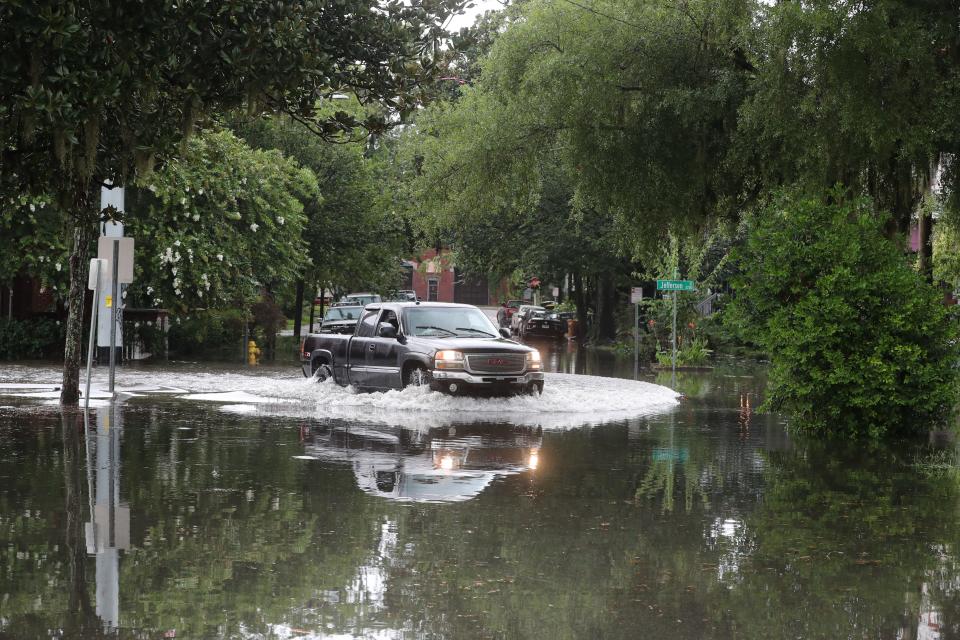Savannah has gotten 2 degrees warmer this century; thank climate change

Savannah felt the effects of climate change in 2023 and will continue to be impacted as a trend of warmer-than-normal weather persists, experts say.
Last year was the sixth warmest since record-keeping began for Savannah in 1874, according to data from the National Weather Service.
Average annual temperatures in the city – measured in both five-year and decade-long increments – have risen more than 2 degrees in this century alone. In fact, the most recent five-year and 10-year periods were the warmest ever in Savannah.
That’s because six of the city’s nine warmest years have been recorded since 2015, including the only time the average annual temperature topped 70 degrees, in 2020.
At No. 2 all time was 2019 (69.8) followed by 2017 at No. 3 (69.3), 2016 at No. 5 (69.1), 2023 at No. 6 (69) and 2015 at No. 9 (68.7).
Worldwide, 2023 was the warmest year on record, according to climate scientists, who warn that a continued rise in heat-trapping fossil fuel emissions will continue to drive the trend.
While rising temperatures have year-round impacts on people and nature, sweltering summers are becoming a particularly ominous threat in Southern cities like Savannah, noted J. Marshall Shepherd, a weather and climate expert at the University of Georgia.
“The triple whammy of climate warming, more intense or frequent heatwaves, and urban ‘heat islands’ leads to increasingly worrisome conditions,” Shepherd said.
A 2021 report by the non-profit research organization Climate Central estimated that urban areas of Savannah are nearly 6 degrees warmer than some sections of the city.
In rapidly growing areas like Savannah, new development adds even more fuel to summer’s blast furnace.
Trees and vegetation provide shade and cool surroundings by releasing water vapor into the air through their leaves. As more areas are developed, those green patches are replaced with pavement and buildings that absorb and retain heat.
That makes an increasing number of Savannah residents – because of race, income and age – more vulnerable to extreme conditions, added Shephard, assistant dean at UGA’s Franklin College of Arts and Sciences.
More: Sweltering temperatures raises concern for those experiencing homelessness
‘Rainfall intensity’ becomes primary concern
While Savannah’s warming trend continued in 2023, drier-than-usual conditions persisted for a second straight year.
About 42 inches of rain fell in the city in 2023 – roughly 6 inches below normal, according to the National Weather Service. That followed an even drier 2022 and its 37 inches of precipitation.
Over the past decade, however, Savannah’s annual rainfall has been right around the historical average.
Those figures may appear to contradict predictions of extreme rain events fueled by climate change. That’s not the case, Shepherd said.
“It is important to note that the strongest signal is not necessarily in changing amounts of rainfall but rather intensity,” he explained.
The 5th U.S. National Climate Assessment released in November noted that precipitation trends have been shifting for a half-century.
“More rain falls in more intense bursts now,” Shepherd said. “Basic physics holds that warmer temperatures will accelerate the water cycle and evaporation rates, making more water vapor available to storms.”
Statistics support that theory.
Statewide, Georgia experienced its highest-ever number of rain events totaling 3 inches or more in a five-year span between 2015 and 2020, according to the National Oceanic and Atmospheric Agency’s 2022 State Climate Summaries.
However, warmer conditions affect what happens between rainy periods.
“Even if annual precipitation remains constant, higher temperatures will increase evaporation rates and decrease soil moisture during dry spells, leading to greater drought intensity,” Shepherd explained.

More: Savannah left with downed tress and power outages as Hurricane Idalia moved through GA.
‘Triple-dip’ La Niña to El Niño
While the remnants of Hurricane Idalia downed dozens of trees and took out power lines in Savannah in August, the storm's earlier evolution offered a sobering glimpse into how warming oceans are making storms more intense and unpredictable for potentially vulnerable areas like coastal Georgia.
As Idalia moved through the Gulf of Mexico before making landfall in Florida, its winds strengthened by 55 mph in just 24 hours, pushing it from Category 1 hurricane to a Category 4.
That was about two weeks after water temperatures off the Florida coast hit a global record of 101 degrees. At Tybee Island, readings hit an all-time high of 86.3 degrees in August.
But not only are oceans warming. They're also rising, and doing so at a particularly accelerated rate in the Savannah area.
In early 2023, a Virginia Institute of Marine Science at William & Mary's report found that Savannah ranked third among 32 coastal U.S. cities in projected sea-level rise. The researchers predicted an increase of about 1.5 feet by 2050 in Savannah, with the area experiencing much of that rise earlier than most other studied cities.
More: Savannah's sea level is rising faster than other coastal cities. How is that possible?
While warming oceans offer clear cause and effect, climate quirks also arise from the confluence of trends that would appear to be at opposite ends of the weather spectrum.
In 2022, for example, Hurricane Ian swamped parts of Florida with more than 20 inches of rain. As the storm moved north just off the Atlantic coast, it triggered an inversion of extremely dry air that combined with warming daytime conditions to create a so-called flash drought, explained Georgia State Climatologist Bill Murphey.
"It really hit the agricultural sector hard,” he added. “That was part of the triple-dip La Niña event.”
La Niña conditions develop when equatorial trade winds intensify and cause colder, deeper water to rise to the surface of the Pacific Ocean. The corresponding track of the jet stream makes the Southeastern U.S. generally warmer and drier.
The rare three-year La Niña exposed Georgia to an extended period of conditions conducive to rapidly developing droughts.
“This most recent fall drought in 2023 occurred when we were transitioning back into El Niño and hit during our normal dry months (September through November) when the Gulf of Mexico’s return flow got cut off for an extended period,” Murphey said. “So, lots of factors at play.”
In El Niño periods, warmer waters cause the Pacific jet stream to move south of its neutral position, making the northern U.S. and Canada dryer and warmer than usual, and the Southeast wetter.
“We typically get more precipitation across central and south Georgia during a strong El Niño,” Murphey added. “Hopefully, we’ll get some additional relief in the upcoming couple of weeks across north Georgia where the recent 2023 fall rapid onset drought has really been brutal.”
The year in weather
Here is a look at other Savannah weather highlights for 2023:
Highest temperature: 99 on July 21
Coldest temperature: 27 on December 20
Wettest day: Dec. 17, 3.16 inches of rain
Wettest month: June, 6.85 inches (record is 22.9 inches, September 1924)
Driest month: November, 1.05 inches (record low is a trace, October 2000 and December 1889)
Total rainfall: 42 inches (record high is 74 inches in 1885, lowest is 22 inches in 1931)
John Deem covers climate change and the environment in coastal Georgia. He can be reached at jdeem@gannett.com.
This article originally appeared on Savannah Morning News: Climate change, La Niña fuel one of Savannah's warmest years in 2023

